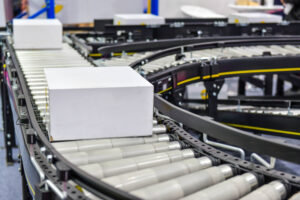Table of Contents
Customers expect their packages within hours, not days, putting immense pressure on distribution centers and fulfillment facilities to process thousands of items with unprecedented speed and accuracy. This is where high-speed sortation systems become not just beneficial, but absolutely essential for competitive survival.
At Lafayette Engineering, we’ve been at the forefront of high-speed sortation systems design and implementation for over three decades. Our expertise in creating custom solutions has helped countless businesses transform their operations, achieving throughput rates that seemed impossible just years ago. In this comprehensive guide, we’ll explore everything you need to know about high-speed sortation systems and how they can revolutionize your warehouse operations.
What Are High-Speed Sortation Systems?
High-speed sortation systems are automated conveyor-based solutions designed to rapidly identify, divert, and route products to their designated destinations within a warehouse or distribution center. These sophisticated systems can process hundreds of items per minute, with the most advanced installations capable of handling over 400 cartons per minute or up to 27,000 cartons per hour.
Unlike traditional manual sorting processes that rely heavily on human labor, high-speed sortation systems utilize advanced control technology, sensors, and mechanical components to automatically direct products based on predetermined criteria such as destination, product type, size, or shipping priority.
Key Components of High-Speed Sortation Systems
Modern high-speed sortation systems integrate several critical components working in perfect harmony:
Advanced Control Systems: At the heart of every high-speed sortation system lies sophisticated software that makes real-time decisions about product routing. These systems interface with Warehouse Management Systems (WMS) and Warehouse Control Systems (WCS) to receive routing instructions and execute them with precision.
High-Resolution Scanning Technology: Barcode scanners, RFID readers, and optical character recognition (OCR) systems identify products as they move through the system at high speeds, ensuring accurate routing even at maximum throughput.
Mechanical Diverting Mechanisms: Various mechanical components physically redirect products to their designated lanes, including sliding shoes, pop-up wheels, tilt trays, and cross-belt technologies.
Safety and Quality Systems: Integrated sensors monitor system performance, detect jams or misrouted items, and ensure worker safety around high-speed equipment.
Types of High-Speed Sortation Systems
1. Sliding Shoe Sortation Systems
Sliding shoe sorters represent one of the most popular choices for high-speed sortation systems in high-volume environments. These systems use diverting mechanisms called “shoes” that slide across the conveyor belt surface to gently push products onto designated destination lanes.
Advantages:
- Exceptional speed capabilities reaching up to 450 feet per minute
- Gentle handling suitable for a wide range of product types
- High accuracy rates with minimal product damage
- Proven reliability in demanding industrial environments
Ideal Applications:
- E-commerce fulfillment centers
- Retail distribution centers
- Parcel sorting facilities
- Manufacturing distribution
2. Tilt Tray Sortation Systems
Tilt tray systems feature individual trays mounted on a continuous loop conveyor. When each tray reaches its designated destination, it tilts to release the product into the appropriate chute or container.
Advantages:
- Excellent versatility handling various product sizes and weights
- Gentle product handling minimizing damage
- Modular design allowing for easy expansion
- Reliable performance with minimal maintenance requirements
Considerations:
- Larger spatial requirements compared to other systems
- Moderate speed capabilities suitable for most applications
3. Cross-Belt Sortation Systems
Cross-belt sorters utilize individual belt segments mounted perpendicular to the main conveyor direction. Products are transported on these individual belts and discharged by reversing the belt direction.
Advantages:
- Superior accuracy for irregularly shaped items
- Excellent for handling delicate products
- Precise control over discharge timing and location
- Ideal for e-commerce applications with diverse product mix
Applications:
- Online retail fulfillment
- Pharmacy and medical supply distribution
- Electronics and fragile goods handling
4. Pop-Up Wheel Sortation Systems
Pop-up wheel sorters represent a cost-effective solution for high-speed sortation systems in facilities with space constraints or moderate throughput requirements.
Advantages:
- Compact footprint ideal for smaller facilities
- Lower initial investment compared to other systems
- Simple design with reduced maintenance requirements
- Energy-efficient operation
Limitations:
- Best suited for products with flat, uniform surfaces
- Lower throughput rates compared to other high-speed options
- Limited flexibility with irregularly shaped items
Revolutionary Technology: Lafayette Magnetic Sortation (LMS) System
As leaders in high-speed sortation systems innovation, Lafayette Engineering has developed the groundbreaking Lafayette Magnetic Sortation (LMS) system. This patented technology represents a quantum leap forward in sortation efficiency and reliability.
The LMS system employs electromagnetic technology instead of traditional mechanical components, using multiple magnets to create magnetic fields that precisely control product movement and sortation. This innovative approach eliminates many drawbacks associated with conventional mechanical systems.
Key Benefits of LMS Technology:
- Exceptional speed capabilities up to 725 feet per minute
- Virtually silent operation reducing noise pollution
- Minimal mechanical wear resulting in lower maintenance costs
- Enhanced reliability with fewer moving parts
- Improved energy efficiency compared to traditional systems
Since its introduction, Lafayette Engineering has successfully installed and supported over 250 LMS switches across various industries, demonstrating the system’s proven performance and reliability.
Benefits of Implementing High-Speed Sortation Systems
1. Dramatic Productivity Improvements
High-speed sortation systems can transform warehouse productivity by processing thousands of items per hour with minimal human intervention. Facilities typically experience 300-500% increases in sorting throughput compared to manual processes.
2. Enhanced Accuracy and Quality Control
Automated sorting virtually eliminates human error in product routing. Advanced scanning and verification systems ensure that products reach their correct destinations with accuracy rates exceeding 99.5%.
3. Significant Labor Cost Reduction
By automating the sorting process, facilities can redeploy valuable human resources to higher-value activities such as quality control, customer service, and strategic planning. This workforce optimization often results in 40-60% reductions in sorting-related labor costs.
4. Improved Customer Satisfaction
Faster, more accurate order processing directly translates to improved customer satisfaction through reduced delivery times and fewer shipping errors. In today’s competitive marketplace, this can be a significant differentiator.
5. Scalability for Business Growth
Modern high-speed sortation systems are designed with modularity in mind, allowing facilities to expand capacity as business grows without completely replacing existing infrastructure.
6. Enhanced Data Visibility and Analytics
Sophisticated control systems provide real-time performance data and analytics, enabling continuous optimization and informed decision-making about warehouse operations.
Industries Benefiting from High-Speed Sortation Systems
E-commerce and Online Retail
The explosive growth of e-commerce has made high-speed sortation systems essential for meeting customer expectations for rapid delivery. These systems enable fulfillment centers to process diverse product mixes efficiently while maintaining accuracy.
Third-Party Logistics (3PL) Providers
3PL companies rely on high-speed sortation systems to serve multiple clients efficiently, providing the flexibility to handle various product types and shipping requirements within a single facility.
Manufacturing and Distribution
Manufacturers use high-speed sortation systems to efficiently distribute products to retail locations, ensuring timely delivery while minimizing logistics costs.
Postal and Parcel Services
Shipping companies depend on high-speed sortation systems to handle the massive volumes of packages moving through their networks daily, particularly during peak seasons.
Implementation Considerations for High-Speed Sortation Systems
Facility Assessment and Planning
Successful implementation begins with a comprehensive analysis of current operations, throughput requirements, product characteristics, and facility constraints. This assessment forms the foundation for system design and configuration.
Integration with Existing Systems
High-speed sortation systems must seamlessly integrate with existing Warehouse Management Systems (WMS), inventory management systems, and shipping software to ensure smooth operations and data flow.
Training and Change Management
Implementing new sortation technology requires comprehensive training programs for operators, maintenance personnel, and management to ensure optimal system utilization and performance.
Maintenance and Support Planning
Establishing robust maintenance programs and support relationships is crucial for maximizing system uptime and performance throughout the equipment lifecycle.
ROI and Performance Metrics
Organizations investing in high-speed sortation systems typically achieve return on investment within 12-24 months through:
- Reduced labor costs
- Increased throughput capacity
- Improved accuracy and reduced error costs
- Enhanced customer satisfaction and retention
- Operational efficiency gains
Key performance indicators to monitor include:
- Items sorted per hour
- Sorting accuracy rates
- System uptime and availability
- Labor productivity metrics
- Order fulfillment cycle times
Future Trends in High-Speed Sortation Systems
The evolution of high-speed sortation systems continues with emerging technologies including:
- Artificial intelligence and machine learning optimization
- Advanced robotics integration
- Internet of Things (IoT) connectivity for predictive maintenance
- Augmented reality for maintenance and training
- Sustainable design focusing on energy efficiency
Partner with the Leaders in High-Speed Sortation Systems
With over 35 years of experience in designing and implementing high-speed sortation systems, Lafayette Engineering has the expertise to transform your warehouse operations. Our comprehensive approach includes system design, installation, integration, training, and ongoing support to ensure your investment delivers maximum value.
From our innovative LMS technology to proven traditional sortation methods, we offer solutions tailored to your specific requirements and operational goals. Our nationwide presence ensures local support and rapid response times wherever your facility is located.
The demand for faster, more accurate order fulfillment will only continue to grow. Investing in high-speed sortation systems today positions your organization for success in an increasingly competitive marketplace. Contact Lafayette Engineering to discover how our sortation expertise can drive your operational excellence and business growth.
Ready to explore how high-speed sortation systems can revolutionize your operations? Visit lafayette-engineering.com to schedule a consultation with our sortation experts and take the first step toward transforming your warehouse productivity.


